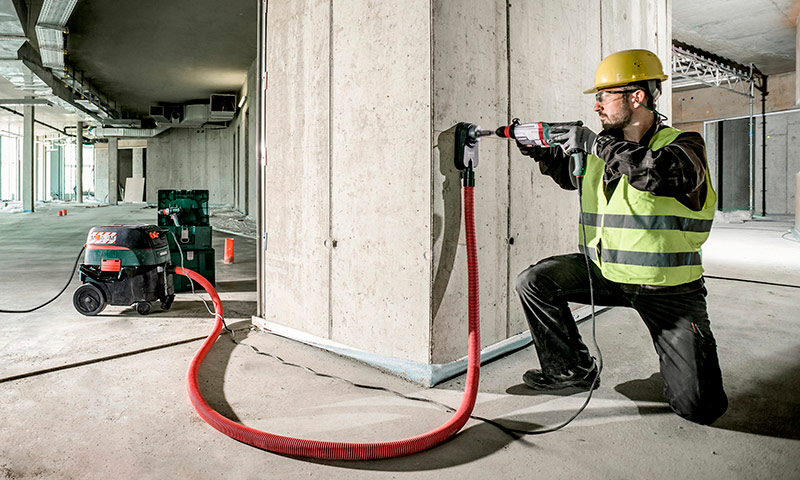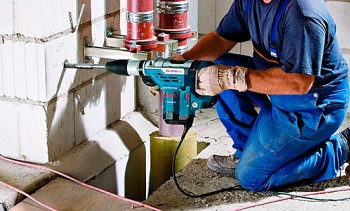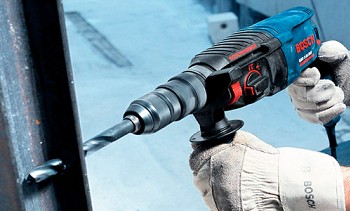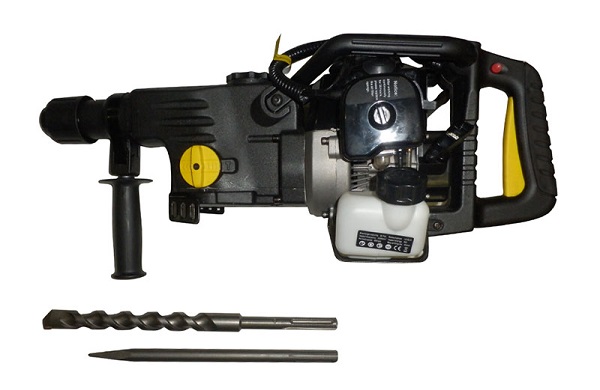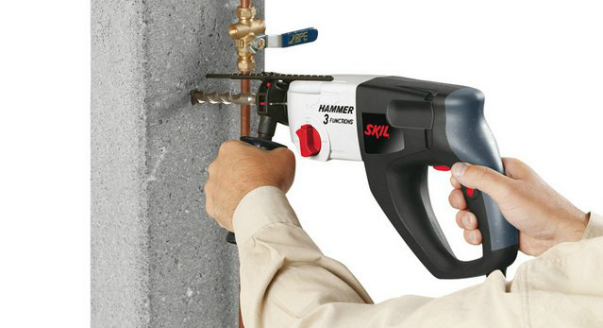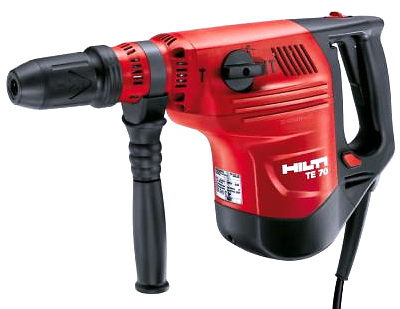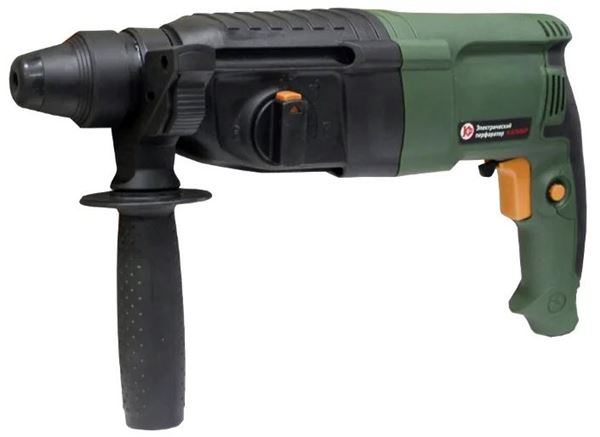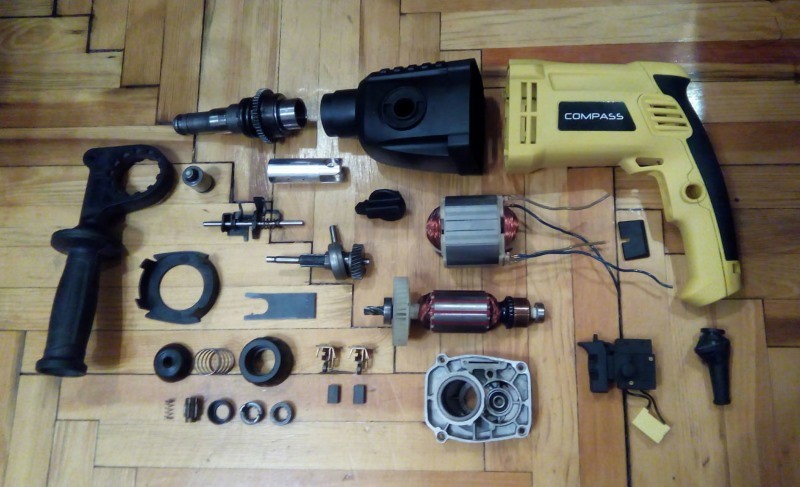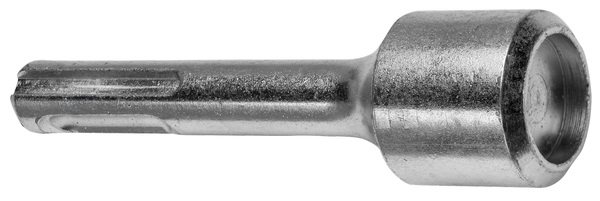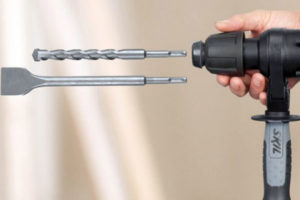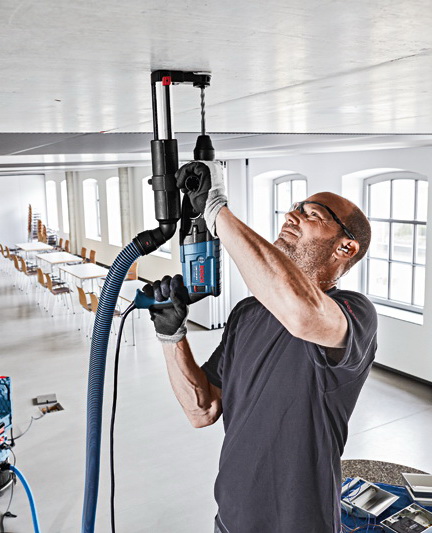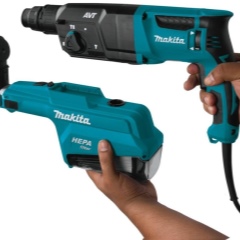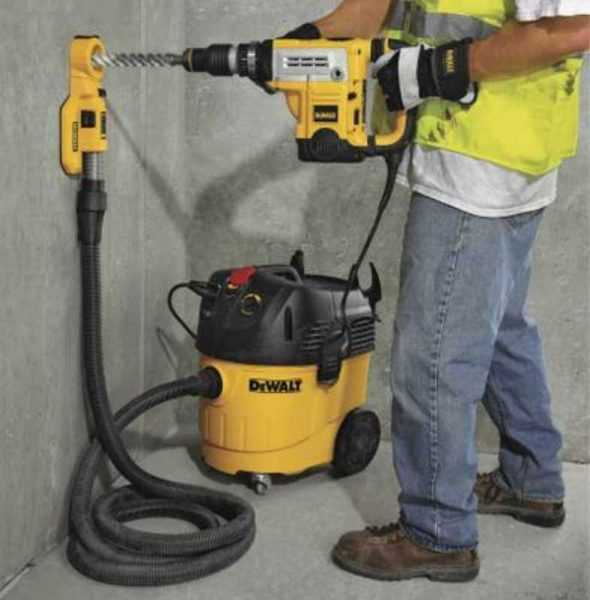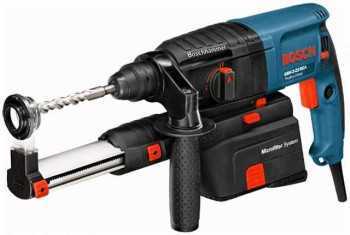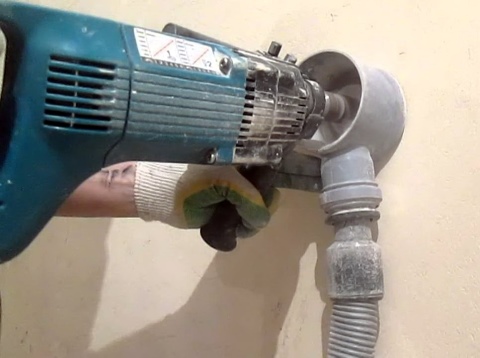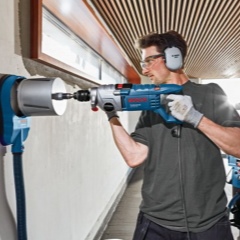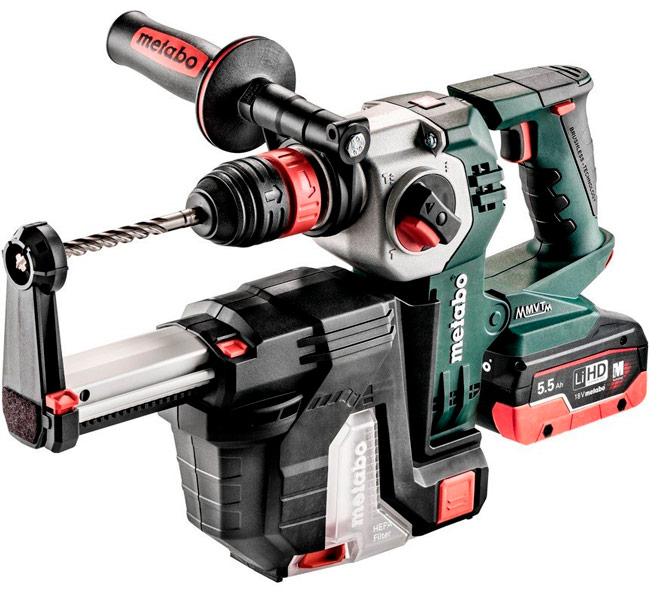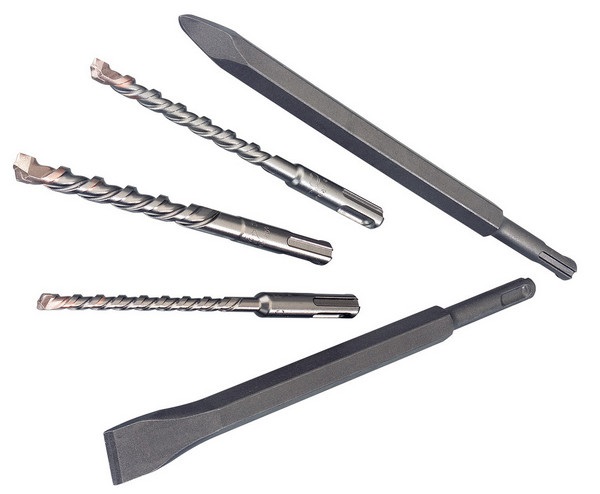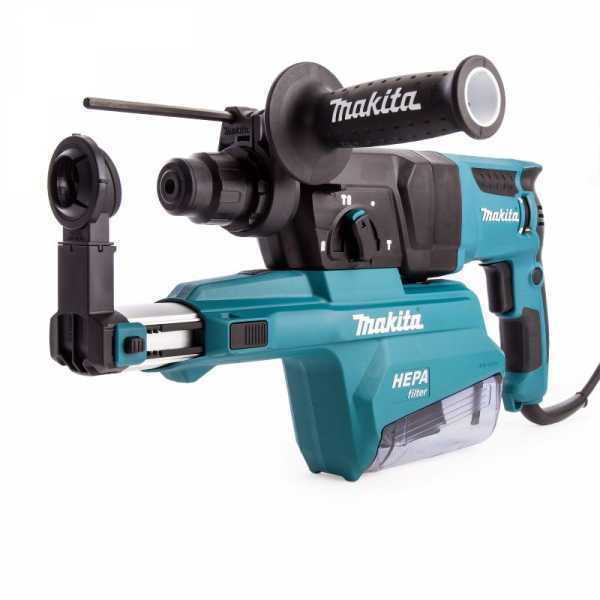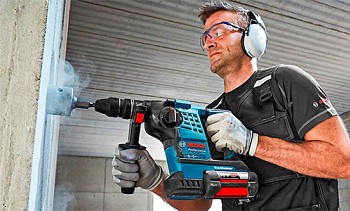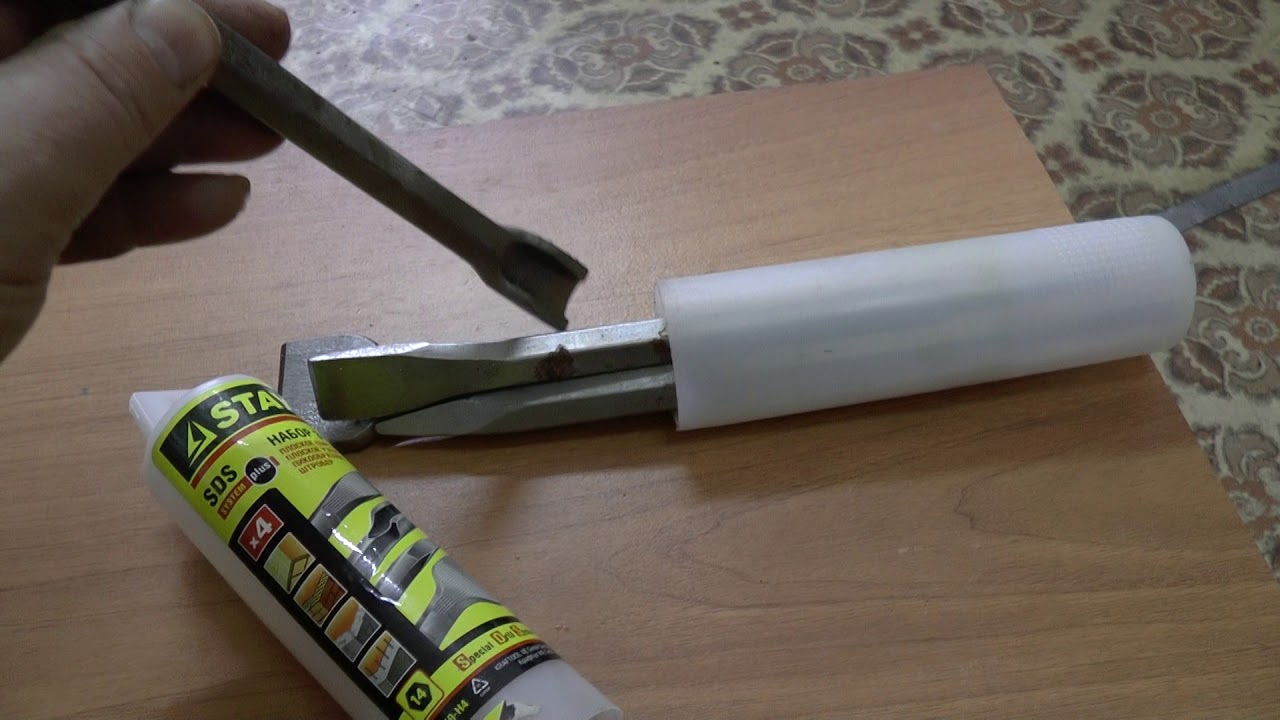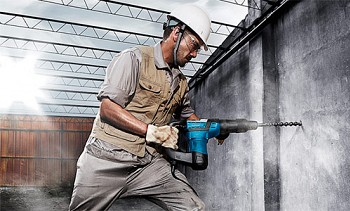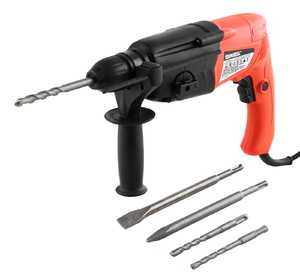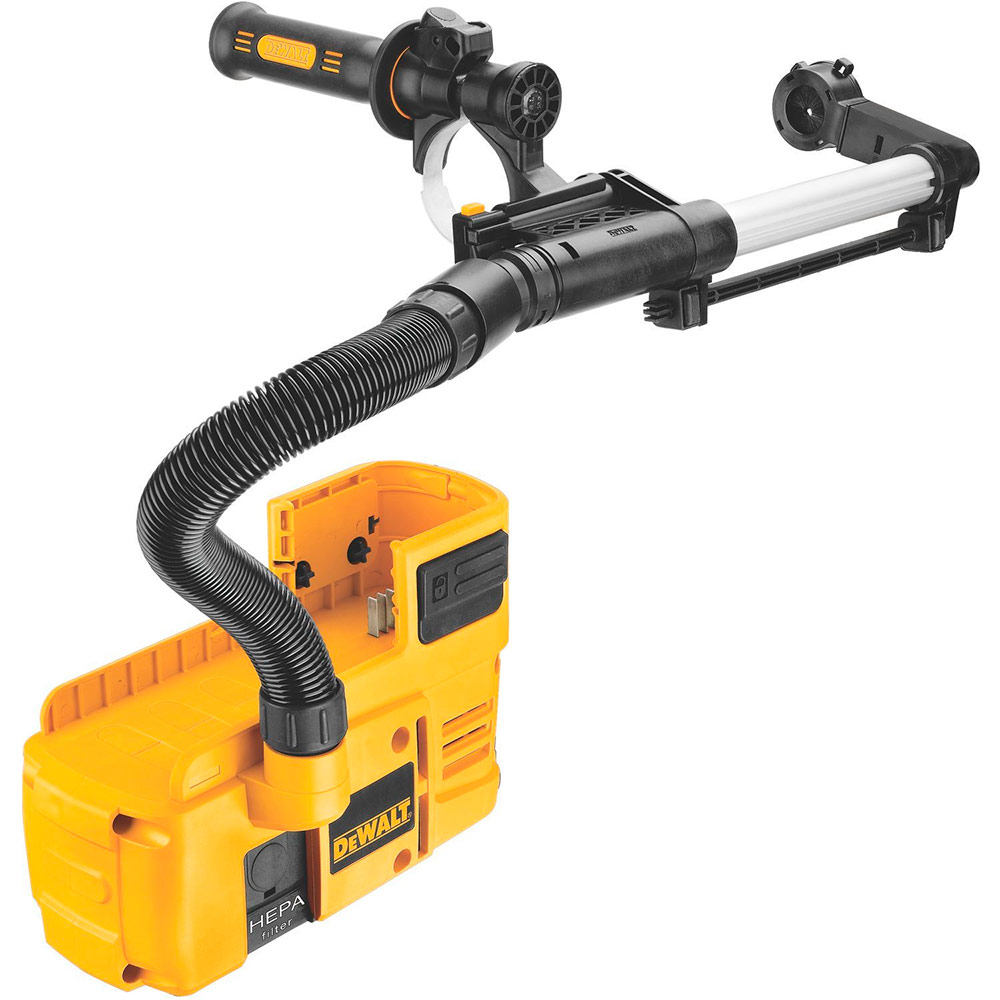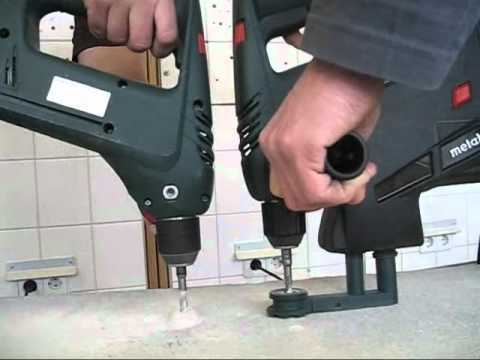Homemade dust collectors
For a long time, paper and scotch tape were considered the simplest dust collector - there is simply no simpler design and will not be. From these materials, you can make a simple envelope that is glued in place of the future hole. Dust settles inside the envelope, but if the drilling is vertical, then you can use a glass of paper. The disadvantages include the fact that some of the dust will still fly out under the influence of air. The advantages include simplicity and low cost.
A cut-off bottom of a plastic bottle is often used.
If we look at the perforator device, we will pay attention to the fact that its engine is equipped with a fan for cooling during operation. This device can be used to make a dust collector on a hammer drill.
To do this, you can take a hose and a plastic polypropylene corner for a 20 mm pipe and drill a hole in it for a drill. Then you need to take a container for dust and make a hole in it for the suction device of the perforator. Dust goes into the box when drilling.
The best rotary hammers with a vacuum cleaner
Having considered the varieties of attachments and equipment for the removal of construction small debris, let's move on to the rating of specific models. Here are the best hammer drills with a built-in vacuum cleaner that have good performance and have the most positive reviews from customers.
Makita HR 2432
The first place in the rating was taken by a Japanese hammer drill with a vacuum cleaner from the Makita company. The vacuum flow is created from the blades located in the middle of the body, from where the tube extends to the cartridge. The HR 2432 model has a power of 780 W and rotates the spindle at speeds up to 1000 rpm. In order not to destroy the gearbox when the drill gets jammed, a safety clutch is provided in the design. When rotated, the striker strikes up to 4500 per minute, which contributes to accelerated drilling. In concrete, they will be able to make a hole with a diameter of 24 mm. In wood, this figure will be 32 mm.
Watch product video
+ Pros of Makita HR 2432
- The container for collecting small particles can be easily removed and washed.
- Electronic reverse and speed control.
- Three modes for different tasks.
- Large garbage bag.
- Cons of Makita HR 2432
- The cloth bag allows small particles to pass through.
- The tool weighs 3 kg, so your hands get tired quickly.
- A large bag, one third full, interferes with manipulations at height - you have to tie it up.
Output. The hammer drill with its own vacuum cleaner has a narrow design of the suction system. It is located on a telescopic stand that adjusts to the length of the drill. The dust collector is about 30 mm in diameter. We recommend taking a closer look at this model for those who have to drill holes in narrow, hard-to-reach places (between pipes, cables, furniture).
Bosch GBH 2-23 REA Professional
The second place in the rating was taken by a model from the German manufacturer "Bosch". The hammer drill has a rigid block attached to the bottom of the engine compartment. There is a channel leading to the blades and a dust container. To adapt to the length of the drill, a telescopic system is provided. The motor power of 710 W spins the spindle up to 1000 rpm and allows up to 4400 strokes. If you use a crown, then a hole with a diameter of 68 mm will be made in the concrete.
Watch product video
+ Pros of Bosch GBH 2-23 REA Professional
- A rubber shell is made around the coupling, which increases the tightness.
- It is easy to change the length of the canal by pressing the button.
- Debris will not seep out of the sturdy plastic container.
- The 3 m long cable increases the craftsman's maneuverability.
- Cons Bosch GBH 2-23 REA Professional
- Work has to be stopped frequently to clear the dust from the container.
- To turn on the reverse, you need to turn the brushes.
- The hands get tired from the weight of 3.6 kg.
- High cost of consumables (O-rings, filter, brushes).
Output. The hammer drill has a good view from the top of the drill entry point. The entire garbage disposal system is implemented from below, so nothing covers the view for the master. We recommend this product for those who need to drill holes with increased accuracy.
Metabo KHA 18 LTX BL 24 Quick Set ISA 0
The third in the ranking is the product from Metabo. It is a powerful tool that spins the chuck up to 1200 rpm and delivers 4500 strokes. In concrete, he can easily drill a hole with a diameter of 24 mm. The design is equipped with an anti-vibration system, which reduces the load on the operator. The model has electronic overload protection. The vacuum cleaner is here attached to a transverse motor. It can be completely unfastened by pressing the button. The suction head is easy to replace.
Watch product video
+ Pros of Metabo KHA 18 LTX BL 24 Quick Set ISA 0
- The level of the container's filling is clearly visible through the transparent window.
- Comfortable grip and rubberized handle.
- Three modes of operation.
- Complete autonomy from sockets.
- Easy adjustment of telescope length.
- Cons Metabo KHA 18 LTX BL 24 Quick Set ISA 0
- The large size of the battery and dust container makes it difficult to access tight spaces.
- Hands get tired from a lot of weight.
- Battery power is quickly depleted.
Output. Since this rotary hammer with a vacuum cleaner is powered by a battery, it is in demand on objects that are not connected to the power supply network. But judging by the reviews of the masters, the battery sits down in it very quickly (due to the high engine power), so it should not be used for large-scale tasks.
What is it for?
Many will not even think about what the function of a vacuum cleaner in a perforator is for.
It's no secret that dust appears during the operation of the hammer drill. Its quantity and composition depends on the material with which the work is carried out. Someone will consider the presence of dust not so much of an inconvenience, but it should not be underestimated either.
- In the dust there are also very small particles that settle on the skin and clothing of a person. If they are constantly inhaled, respiratory diseases, as well as allergic reactions, may appear. In addition to a vacuum cleaner, it is imperative to use a respirator and protective clothing.
- This affects the convenience of the person. Working in dust is not very pleasant, but it is simply impossible to hold a regular vacuum cleaner and work with a puncher at the same time. For people whose daily work is associated with this tool, the presence of a dust collector in it will greatly facilitate the work.
- Small dust particles have a negative effect on the operation of the construction tools themselves. For example, the boot on the cartridge may fail.
- After any work performed with a conventional hammer drill, a thorough cleaning is required.
Views
All rock drills with different types of dust collection systems can be roughly divided into professional and amateur (for home use). Due to their high power and weight, professional ones are designed for certain types of work. Tools for regular use often combine several modes, they are less powerful, and they are lightweight. Naturally, the cost of the former is several times higher.
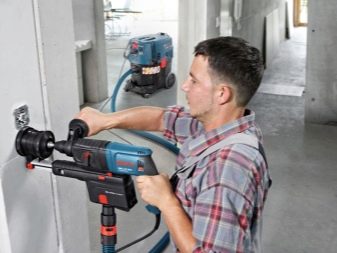
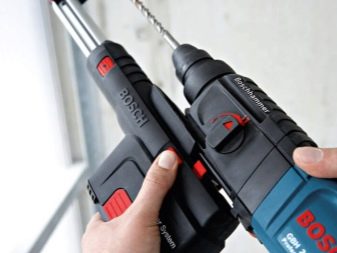
Only a person who uses a puncher regularly, on a professional basis, can afford to buy them. With the help of the latter, it is quite possible to make simple repairs with your own hands or periodically make several holes for household needs. Devices for collecting dust and small debris can be of different designs.
- A special dust extraction system to which a construction vacuum cleaner can be connected. Their main advantage is their high power and the ability to absorb large amounts of debris.Portable construction vacuum cleaners do not greatly affect mobility and convenience. Larger industrial vacuum cleaner models often have power tool sockets, which is also convenient. In this case, each device works autonomously.
- Built-in vacuum cleaner, the work of which is directly connected to the rotary hammer motor. It can be completely removable or only part of the container (bag) for collecting waste. Such a dust collector partially hides the power of the rock drill and affects its durability. This system is suitable for instruments with light to medium characteristics.
- Dust collectors. The essence of the action of which is that they do not allow small particles to scatter in different directions and retain them inside the chamber. Usually these are plastic nozzles in the form of a cone (also called dust caps) or a cylinder. They come in a solid or ribbed cuff that can compress slightly and provide a snug fit. Some of them still have an entrance to which you can connect the hose of a regular household or construction vacuum cleaner. The choice of such dust collectors depends on the type of cartridge, the model of the tool and the maximum possible parameters of the hole (depth and diameter).
Popular models
To make the advantages and disadvantages of perforators with vacuum cleaners more clear, consider several popular models.
Bosch GBH 2-23 REA has proven itself exceptionally well. The design of the vacuum cleaner is easily removable. Inside you can see a filter and a container for collecting small construction waste, which is quite easy to clean. Without a filter, the tool works like a conventional hammer drill with two modes. It copes well with the declared functions, retains more than 90% of dust and is convenient for transportation.
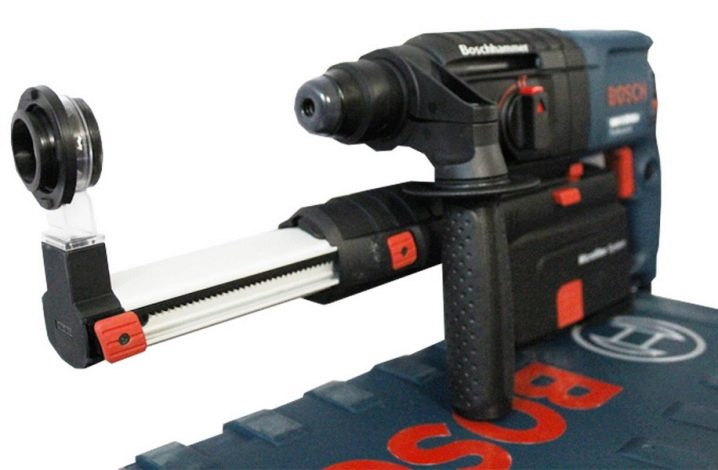
The storage container is large enough to store the hammer drill when assembled.

These two models with dust extractors are not the only ones, there are not so many of them on the market, but there is a choice.
However, the choice of tool depends on the planned work. To hang several paintings, you can take the first model. For larger actions, the second is better.
Types of dust removal systems for rock drills
During the operation of the hammer drill, the drill greatly crushes concrete or brickwork, therefore a lot of dust is formed in the air. She is dangerous for respiratory organs and human skin, contaminates the workplace, impairs the visibility of the marked lines, penetrates into the ventilation holes of the instrument itself. To prevent its spread, various fine particle collection systems have been developed. There are three main types.
Dust collector - cheap and cheerful
The simplest and cheapest design, made in the form of a cone or cylinder. The material is plastic or ABS with the addition of rubber, forming a ribbed cuff. The dust collector is put on the cartridge and prevents the dust coming out from under the drill from flying away. Perforators with a dust collector are especially effective when drilling in the ceiling - then small particles fall straight down and are completely collected in the nozzle. When working on vertical surfaces, the degree of cleanliness depends on how firmly the dust bag is pressed against the wall.
Such a device is inexpensive and you can even make it yourself, but it is only suitable for periodic work (hang a shelf in the bathroom, install a mirror in the hallway, etc.). The container does not collect all the dust. Its length is also limited, so it is not compatible with drills of 150 mm and larger.
Versions of execution of dust collectors for a hammer drill.
Dust extraction system for working with a construction vacuum cleaner - convenient and efficient
To remove a large amount of dust, special nozzles have been developed that are put on the cartridge. They surround the drilling area with a dense rubber-shell hull, preventing debris from spreading.The design has an outlet that is connected through a flexible hose to a powerful construction vacuum cleaner. Thanks to this, small particles of concrete do not accumulate in the collar, but are immediately removed into the dustbin of the suction machine.
The advantage of such equipment is increased power and the ability to absorb large amounts of debris. The room is kept clean. When it is required to drill a series of holes on one wall, it is easy to change the entry point by moving along the partition. The vacuum cleaner has its own motor, which does not "steal" the power of the hammer drill. But the master needs to carry a vacuum cleaner with him, which affects the volume of the transported cargo. Considering the efficiency of the system, such a device is justified for professional use.
Dust extraction systems
Rotary hammer with vacuum cleaner - all inclusive
Perforators with a vacuum cleaner are something average in terms of mobility and efficiency. The latter is an additional unit that attaches to the body of the tool and is powered by its motor. Due to the rotation of the blades, a suction effect is created that absorbs the ejected dust. If necessary, the vacuum cleaner can be unfastened (completely or partially) to reduce the size of the tool for working in hard-to-reach places.
It is easier to transport such a tool than a hammer drill with a construction vacuum cleaner and a dust extraction system. But in terms of power, this solution loses, since the suction power is weaker. Using a single motor to rotate the chuck and absorb dust reduces the power of the equipment and shortens its service life. This implementation of the dust removal system is suitable for intermittent use, for example, for minor repairs in the office or the installation of shelves and furniture in offices, hospitals, kindergartens.
Conclusion
To summarize, it is better to stop the choice, of course, on factory dust collectors, since they are convenient, compact and do not require additional manufacturing and installation work. This is an option for those who prefer not to skimp on technical means. For those who prefer to put their engineering skills into practice, you can use homemade options. True, they will not get rid of dust by 100%, but this is a less costly method, although more laborious.
Everyone chooses their own tool and its technical revision. The main thing is that it contributes to the comfort and ease of the work process.

